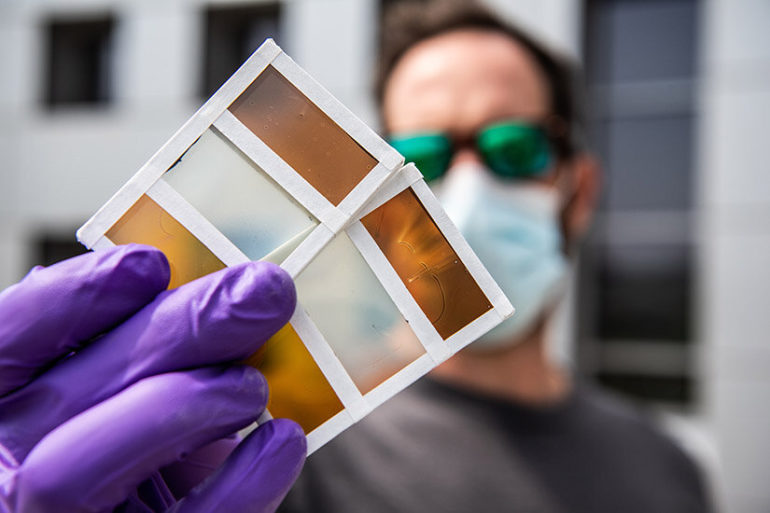Scientists at the U.S. Department of Energy’s National Renewable Energy Laboratory (NREL) report a breakthrough in developing a next-generation thermochromic window that not only reduces the need for air conditioning but simultaneously generates electricity.
Heat generated by sunlight shining through windows is the single largest contributor to the need for air conditioning and cooling in buildings. Because residential and commercial buildings use 74% of all electricity and 39% of all energy in the United States, the shading effect from tinting windows helps buildings use less energy.
The technology, termed “thermochromic photovoltaic,” allows the window to change color to block glare and reduce unwanted solar heating when the glass gets warm on a hot, sunny day. This color change also leads to the formation of a functioning solar cell that generates on-board power. Thermochromic photovoltaic windows can help buildings turn into energy generators, increasing their contribution to the broader energy grid’s needs. The newest breakthrough now enables myriad colors and a broader range of temperatures that drive the color switch. This increases design flexibility for improving energy efficiency as well as control over building esthetics that is highly desirable for both architects and end users.
The research builds upon earlier work at NREL into a thermochromic window that darkened as the sun heated its surface. As the window shifted from transparent to tinted, perovskites embedded within the material generated electricity. Perovskites are a crystalline structure shown to have remarkable efficiency at harnessing sunlight.
“A prototype window using the technology could be developed within a year,” said Bryan Rosales, a postdoctoral researcher at NREL and lead author of the paper, “Reversible Multicolor Chromism in Layered Formamidinium Metal Halide Perovskites,” which appears in the journal Nature Communications. His co-authors from NREL are Lance Wheeler, who developed the first thermochromic photovoltaic window, Taylor Allen, David Moore, Kevin Prince, Garry Rumbles, and Laura Schelhas. Other authors are Laura Mundt from SLAC National Accelerator Laboratory, and Colin Wolden from Colorado School of Mines.
The first-generation solar window was able to switch back and forth between transparent and a reddish-brown color, requiring temperatures between 150 degrees and 175 degrees Fahrenheit to trigger the transformation. The latest iteration allows a broad choice of colors and works at 95 degrees to 115 degrees Fahrenheit, a glass temperature easily achieved on a hot day.
By using a different chemical composition and materials, the researchers also were able to rapidly speed up the color transformation. The time was reduced to about seven seconds from the three minutes it took during the proof-of-concept thermochromic photovoltaic window demonstrated in 2017.
The scientists sandwiched a thin perovskite film between two layers of glass and injected vapor. The vapor triggers a reaction that causes the perovskite to arrange itself into different shapes, from a chain to a sheet to a cube. The colors emerge with the changing shapes. Lowering the humidity returns the perovskite to its normal transparent state.
Additional research is planned. One area to be explored is the number of times the thermochromic window can be cycled into an electricity-generating operating mode and return to transparent. The efficiency of converting sunlight into electricity will also be explored.
NREL develops switchable solar window
More information:
Bryan A. Rosales et al. Reversible multicolor chromism in layered formamidinium metal halide perovskites, Nature Communications (2020). DOI: 10.1038/s41467-020-19009-z
Provided by
National Renewable Energy Laboratory
Citation:
Colorful perovskites: Lab advances thermochromic window technologies (2020, October 19)
retrieved 20 October 2020
from https://techxplore.com/news/2020-10-perovskites-lab-advances-thermochromic-window.html
This document is subject to copyright. Apart from any fair dealing for the purpose of private study or research, no
part may be reproduced without the written permission. The content is provided for information purposes only.



